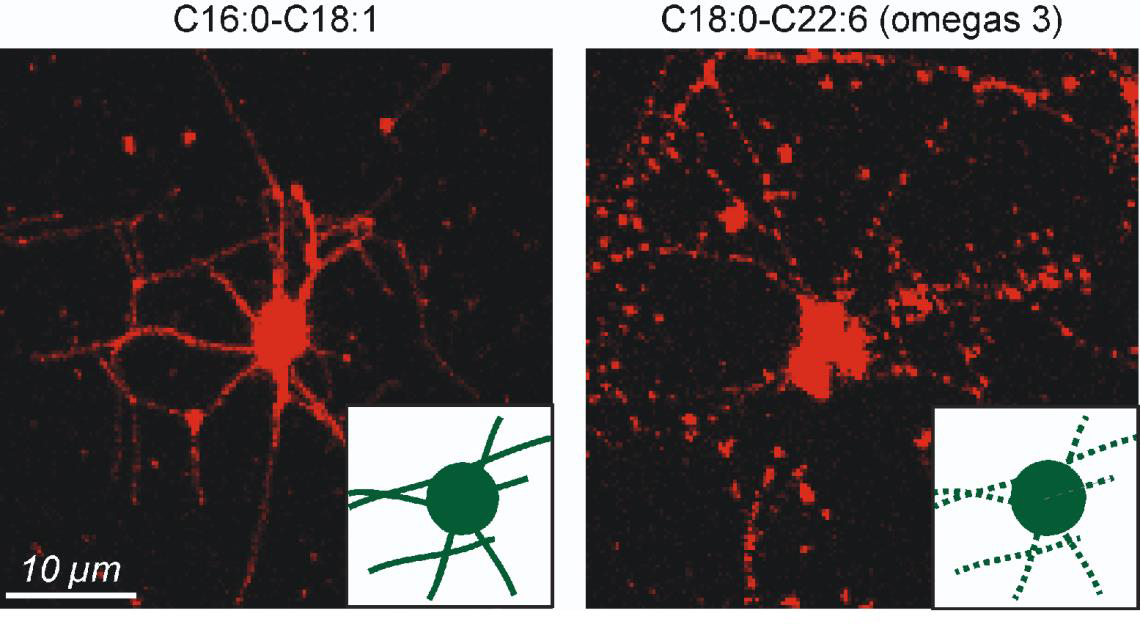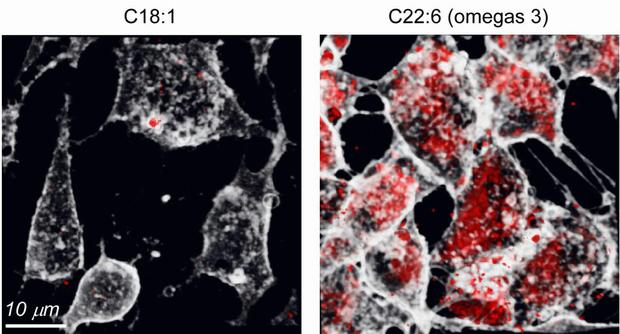Scientifically, any mechanisms underlying this phenomenon are poorly known. Researchers recently investigated the effect of lipids bearing polyunsaturated chains when they are integrated into cell membranes. Their work shows that the presence of these lipids makes the membranes more malleable and therefore more sensitive to deformation and fission by proteins.
The results could help explain the extraordinary efficacy of endocytosis - the process by which the cells absorb various substances present in the surrounding medium by encapsulating them in a lipoprotein membrane - in neuron cells.

Membranes containing monounsaturated (left) and polyunsaturated (right) lipids after adding dynamin and endophilin. In a few seconds membranes rich in polyunsaturated lipids undergo many fissions. © Copyright : Mathieu Pinot
Consuming polyunsaturated fatty acids (such as omega-3 fatty acids) is recommended and the attributed effects range from neuronal differentiation to protection against cerebral ischemia (1). However, since molecular mechanisms underlying these effects are poorly understood, researchers have focus on the role of these fatty acids in cell membrane function to try and determine the validity of the claims.
For a cell to function properly, the membrane must be able to deform and divide into small vesicles. This phenomenon is called endocytosis. Generally, these vesicles allow the cells to encapsulate molecules and transport them.. In neurons, these synaptic vesicles will act as a transmission pathway to the synapse for nerve messages. They are formed inside the cell, then they move to its exterior and fuse with its membrane, to transmit the neurotransmitters that they contain. Then they reform in less than a tenth of a second: this is synaptic recycling.
In the recent work, researchers show that cell- or artificial membranes rich in polyunsaturated lipids are much more sensitive to the action of two proteins, dynamin and endophilin, which facilitate membrane deformation and fission. Other measurements in the study and in simulations suggest that these lipids also make the membranes more malleable.

Transferrin (iron transport) endocytosis in cells containing polyunsaturated lipids in their membranes (right) compared to those of cells without polyunsaturated lipids (left). In 5 minutes, the number of endocytosis vesicles formed (transferrin brought in is red) is increased by almost a factor of 10, reflecting easier endocytosis. © Copyright : Hélène Barelli
By facilitating the deformation and scission necessary for endocytosis, the presence of polyunsaturated lipids could explain rapid synaptic vesicle recycling.. The abundance of these lipids in the brain could then represent a major advantage for cognitive function.
This work partially sheds light on the mode of action of omega-3. Considering that the body cannot synthesize them and that they can only be supplied by a suitable diet (rich in oily fish, etc.), it seems important to continue this work to understand the link between the functions performed by these lipids in the neuronal membrane and their health benefits.
Citation: Polyunsaturated phospholipids facilitate membrane deformation and fission by endocytic proteins; M. Pinot, S. Vanni, S. Pagnotta, S. Lacas-Gervais, L.A. Payet, T. Ferreira, R. Gautier, B. Goud, B. Antonny and H. Barelli; Science; 8 August 2014.
Notes:
This study was conducted in collaboration with teams from the Centre Commun de Microscopie Appliquée (Université Nice Sophia Antipolis) and the Laboratoire Signalisation et Transports Ioniques Membranaires (CNRS/Université de Poitiers/Université François Rabelais de Tours).
(1) See for example prior work by the Institut de Pharmacologie Moléculaire et Cellulaire on this type of stroke: Polyunsaturated fatty acids are potent neuroprotectors; Lauritzen I, Blondeau N, Heurteaux C, Widmann C, Romey G, Lazdunski M; EMBO J. (2000) 19:1784-93.





Comments